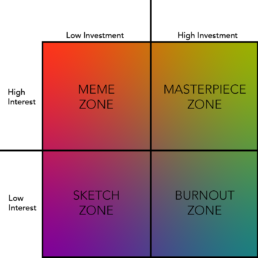2019 Artist Survey
Hey artists, do you have the technology skills and resources you need to accomplish your 2019 goals? To better meet the needs of the creative community, I’m collecting information about what you want to do and learn this year.
Help me out! Click on the button below to complete a 2-minute survey about your technology needs. One lucky participant will win a portfolio website (with 1 year of free hosting). The winner can use this prize to promote their own artistic work, or they can gift it to another deserving artist.
Can You Avoid Artistic Burnout by Imitating Amazon and Facebook?
How many artists do you know who burn out? Or give up on a project, or lose interest, or just stop making work altogether?
Chances are, you’ve met a few. You may have even been that person!
Creative burnout is common because being an artist is inherently risky. It requires large amounts of invested time and effort but when work is finally released, when the big day arrives, artists (especially new artists) face disinterest far more frequently than success.
Every time an artist makes something new, they take a gamble on whether an audience will connect, and that gamble doesn’t always pay off. That’s discouraging for anybody.
But hold on! Many industries have found ways to reduce risk, so why can’t artists do the same? How can we think of creative projects more like commercial products while still keeping the artist’s journey and passion in mind?

The graph above categorizes creative projects into four quadrants, based on the amount of investment versus interest. Investment could be time, money, effort, emotion, etc. Interest is the demonstrable ability for a piece to generate an audience. (This doesn’t necessarily mean financial success.)
The Sketch zone is where creative projects start and where most ideas live and die. Few (or no) people may know about the work, and the artist has only invested a little. Changes can occur with little consequence. Crazy and boring ideas mix. Everything is rough and wild.
The goal, naturally, is to end up in the masterpiece zone, which is for works that not only interest a large audience but also are difficult to replicate because of the artist’s investment.
A natural response to a good idea is to start work straightaway. As the artist invests more on the finished piece, however, they get pushed into the Burnout zone, where the work may face an uphill battle in generating interest and may be difficult or impossible to change.
The alternative is to take a sketch-level idea and distribute as widely as possible to generate interest, but this pushes a work into the Meme zone, where it’s easily replicated, stolen, and recycled by others.
The best way to get to the masterpiece zone would be to zigzag incrementally and often, avoiding the downsides of the Burnout and Meme zones while building interest and investment in equal proportion.
Technology companies such as Facebook and Amazon zigzag when launching a new product or feature. They understand that spending months developing something behind closed doors can be dangerous if users decide it’s not valuable to them.
One technique used to reduce product risk is to prove concept by creating a smaller or simpler version first in order to get early feedback, and then scaling and iterating up in multiple rounds. Many people call this a minimum viable product approach, or prototyping, or the cupcake rule.
Another technique is called “working backward.” In short, it involves writing the press release first and defining the user’s experience before committing to any specific requirements.
To put these two techniques in use for myself, I will experiment by applying them to crime fiction. Can I create a minimum viable product that tests a story and defines the reader’s experience before writing the novel?
First, I want to test and prove concepts by using Instagram to gauge interest in specific characters, crimes, settings, themes, etc. Using whatever insight I can gather, I will then create standard marketing materials for at least one novel idea.
The goal is to create promotional content that reliably compels someone to read a sample.
Follow me at @milesasaurus to watch this project unfold and participate in the story creation!
How could you use these two techniques to improve the creative process? How would you use them in your personal pursuits? [READERS: Use comments below, I’d love to know.]